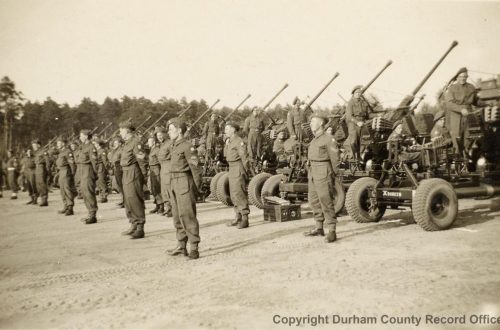Lt. T.D.J Finnie (13 Regt. RHA)
My Grand-father is Maj.T.D.J.Finnie RA (Retd.) but not sure of the dates he would have been there.
I’ll let you know what he says. He also wrote an article on the liberation that appeared in “Gunner” magazine, the RA magazine. He was in 13 Regt. RHA (Honourable Artillery Company).
He retired in 1953 as a Major, but IIRC he would have been an Lt. at the time (he referred to himself at the time as a 23 year old subaltern.
Here follows some correspondence of his from a couple of years ago to a USN Capt. doing reserach for a Holocaust Museum in Richmond, Virginia. It is not entirely on topic, but hopefully is of interest:
Altho’ not a member/ex member I respond to your appeal to 113 LAA Regt in the Dec ’04 issue of the ‘Gunner’ . I recall involvement, at Belsen, of officers of the LAA Regt in 11 Armd. Div at the time, but don’t remember the Regt ident.. Lacking an ORBAT, I accept your view that it was 113. I also accept your date. I was there – but keeping of diaries streng verboten !
At the time I was a Troop Leader of the leading Battery of 13 (HAC) SP Fd Regt RHA armed with ‘ Sextons’ (25 pounders mounted on ‘Sherman’ tank chassis) supporting the leading tank Squadron of 29 Armd Bde. (15/19 Lancers?) in ‘Shermans’.
The head of the Div column halted on the south side of the River Aller, opposite Winsen. Shortly afterwards a German 88 mm, 1 km east of the bridge, lobbed a round 60 yds short of my half-track – and was rapidly silenced by one of our tanks.
Increasingly perplexed by ‘nothing happening’ I did a local recce but found it impossible to get off the raised road or turn to put my troop in action. The left side was thick pine forest; the right a drop into open ground and in view of hostile troops, if any, on the other side of the river, less than 1 km away. The column was similarly stuck in front & behind. Impossible to move.
Always aware how useless guns are if unable immediately to deploy, my Troop Sergeant Major on his own initiative recce’d unsuccessfully to find a gun position the other side of the wood on the left. The wood continued for far too great a distance without promise of a suitable clearing. On their return the driver of the TSM’s Bren carrier did not notice passing beneath a low slung telephone cable across the forest track – which strangled the TSM. The driver of my half-track was the TSM’s younger brother. (You may imagine his feelings and mine. The column ever to be ready to move, he could not leave the vehicle – in fact he just sat there uncomprehendingly anyway poor chap. No further comment from me – and they should remain anonymous).
After a long delay we were told that a cease-fire zone had been created on both sides of the road running north beyond the R. Aller. To the left an area of forest enclosed the concentration camp. To the right, in a couple of square miles of mostly pine forest, an enormous quantity of ammunition of all kinds, including gas shells, had been dispersed and stored. We and the local German population could have been annihilated had a single round landed there.
Clearly we also wanted no friendly round either to fall in the concentration camp – nor break the wire and let the captives free to roam. They had to be contained – for their benefit and ours.
When eventually we moved forward we found the Belsen camp guarded by Hungarian troops in light mustard coloured uniforms – to keep us clear of inmates, despite our enormous natural sympathy. (German troops did not stay — presumably in case they were blamed for the camp – and ‘dealt with’ ?) A few pathetic bedraggled inmates came to the wire, pleading to us in tongues not understood.. 12,000 others were dead or dying inside the camp. All operational troops were forbidden to go anywhere near the wire for fear of catching dread diseases. Despite the ‘Cease Fire’ in that limited area, we were still at war.
Two officers of the divisional LAA Regt (which had had little to do at this stage of the war) were deputed to take charge (of whom?) initially. I was later told the two or three days experience changed their lives. They were no longer the same hale and hearty men when relieved. Presumably they were from 113 Regt. I do not know.
I suggest that, without valid confirmation, you treat any claims by British as to involvement inside the camp with scepticism. Clearing up and burials were done by Germans under high level GHQ control. Formations in the field were still operational at full complement and the war had not then ended. Germans from Celle, 8 miles east were bussed out to witness the scenes.. A film of that was later broadcast (commentary by Richard Dimbleby ?)
By chance, in March 1947 I was posted to 652 AOP Sqn stationed at Celle.. By that time the Belsen camp had been flattened and the dead decently buried – and I had no impulse to revisit the site, nor to take with me my young bride. Although Belsen was clearly visible from a public road, I had detected no trace of concern, let alone guilt amongst the local people. “That was nothing to do with us” Even at that late stage I suppose few would argue with the NAZI party? “I was only carrying out orders” was a mantra later heard repeatedly. There seemed to be no concept of personal responsibility or conscience.
12,887 total views



